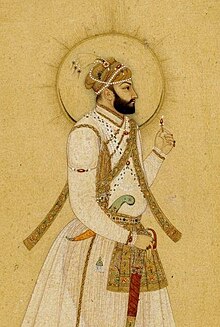
Back جلال الدين محمد فرخ سير Arabic جلال الدين محمد فرخ سير ARZ Fərruxsiyar Azerbaijani فرخسیر AZB फर्रूखसियर Bihari ফররুখসিয়ার Bengali/Bangla Farrukh-siyar Catalan فارۆخسیر CKB Farrukh Siyar German Farrukhsiyar Spanish
| Farrukhsiyar | |||||||||
|---|---|---|---|---|---|---|---|---|---|
 Emperor Farrukhsiyar holding a jewel c. 1717 | |||||||||
| 10th Mughal Emperor | |||||||||
| Reign | 11 January 1713 – 28 February 1719 | ||||||||
| Predecessor | Jahāndār Shāh | ||||||||
| Successor | Rafī-ud-Darajāt | ||||||||
| Born | 20 August 1683 Aurangabad,Ahmadnagar Subah, Mughal Empire | ||||||||
| Died | 9 April 1719 (aged 35) Shahjahanabad, Delhi, Mughal Empire | ||||||||
| Cause of death | Execution by Immurement | ||||||||
| Burial | |||||||||
| Spouse |
| ||||||||
| Issue |
| ||||||||
| |||||||||
| House | House of Babur | ||||||||
| Dynasty | Timurid Dynasty | ||||||||
| Father | Azīm-ush-Shān | ||||||||
| Mother | Sahiba Niswan | ||||||||
| Religion | Sunni Islam (Hanafi) | ||||||||
| Military career | |||||||||
| Battles/wars | |||||||||
| Mughal emperors | ||||||||||||||||||||||||||||||||||||||||||||||
|---|---|---|---|---|---|---|---|---|---|---|---|---|---|---|---|---|---|---|---|---|---|---|---|---|---|---|---|---|---|---|---|---|---|---|---|---|---|---|---|---|---|---|---|---|---|---|
|
||||||||||||||||||||||||||||||||||||||||||||||
Farrukhsiyar (Persian pronunciation: [faɾ.ˈɾux saj.ˈjɑːɾ]; 20 August 1683 – 9 April 1719), also spelled as Farrukh Siyar, was the tenth Mughal Emperor from 1713 to 1719. He rose to the throne after deposing his uncle Jahandar Shah.[1] He was an emperor only in name, with all effective power in the hands of the courtier Sayyid brothers.[2] He was born during the reign of his great-grandfather Aurangzeb, Reportedly a handsome man who was easily swayed by his advisers, he was said to lack the ability, knowledge and character to rule independently. Farrukhsiyar was the son of Azim-ush-Shan, the second son of emperor Bahadur Shah I and Sahiba Niswan.
- ^ Sen, Sailendra (2013). A Textbook of Medieval Indian History. Primus Books. p. 193. ISBN 978-93-80607-34-4.
- ^ Sanjay Subrahmanyam (2017). Europe's India. Harvard University Press. ISBN 9780674977556.